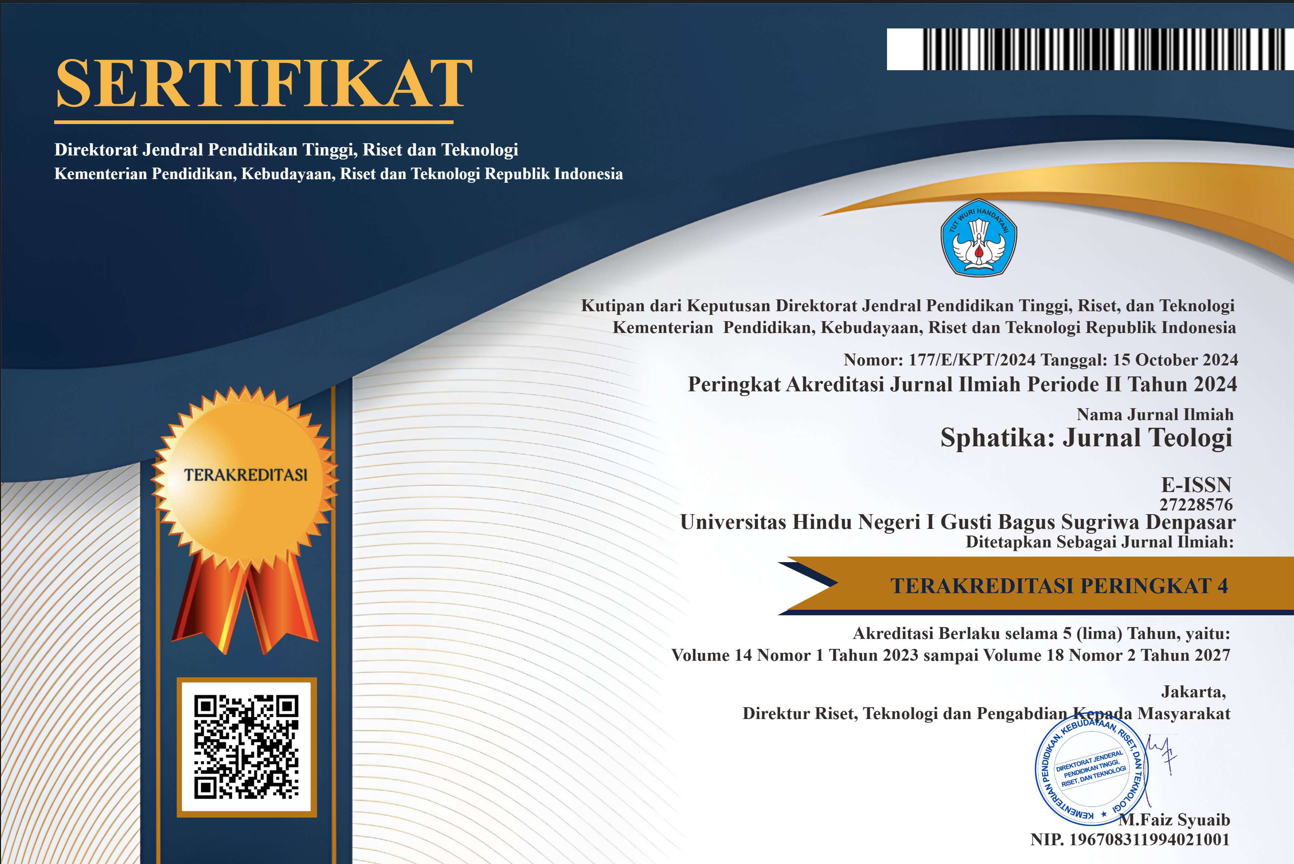Dimensi Keberagamaan Ngestu dalam Upacara Ngaben
DOI:
https://doi.org/10.25078/sphatika.v11i2.1966Keywords:
cremation ceremony; ngestu; social religious.Abstract
Implementation ngestu the cremation ceremony is one effort that was built in the tradition of the community to be able to unite ourselves on the social status, class, social stratification, and social attributes in the social life of the religious. In its implementation uphold a sense of solidarity and togetherness to build egalitarian values for all citizens with the same service. But the objective reality and historical indicate that the Balinese social structure divided into traditional classes where each class has a class solidarity, prestige, and attributes that can be used as a class identity. All of the attributes relating to the status inherent in a person and has important implications on the establishment of a hierarchy of social and previledge which refers to the position of high-low as well as superior and inferior in leader ship of the network system, where the higher grade is considered to have power and authority over spacious with others in the social and religious life in the community. The difference can be deconstructed with realistic thinking with reference to the literature, ie essentially every human being is the same, because it comes from God. Therefore, there is no human reason to distinguish itself with other human beings, because of the social realities on the social attributes of a product of human culture as a result of erroneous interpretation of the teachings of the holy book of the Vedas.
References
Atmadja, Nengah Bawa dan Anantawikrama Tungga Atmaja. 2008. Ideologi Tri Hita Karana –Neoliberalisme Vilanisasi Radius Suci Pura. Dalam Dinamika Sosial Masyarakat Bali dalam Lintasan Sejarah. I Wayan Ardika (Ed.). Denpasar: Swasta Nulus.
Atmadja, Nengah Bawa dan Anantawikrama Tungga Atmadja. 2014. Filsafat Ilmu Pengetahuan: Perspektif Proses dan Produk. Denpasar: Pustaka Larasan.
Bagus, I Gusti Ngurah. 1985. ”Kebudayaan Bali” dalam (Koentjaraningrat, ed) Manusia dan Kebudayaan di Indonesia. Jakarta: Jambatan.
Cresswell, J.W.1998, Qualitative Inquiry and Research Design: Choosing Among Five Traditions, New Delhi: Sage Publications.
Iskandar. 2009. Metodologi Penelitian Kualitatif. Jakarta: Gaung Persada (gp prees)
Kerlinger, Fred N. 2002. Asas-asas Panelitian Behavioral. Yogyakarta: Gadjah Mada University Press.
Pals, Daniel L. 2012. Seven Theories of Religion Tujuh Teori Agama Paling Komprehensif. Jogjakarta: IRCISoD.
Pudja, Gde. 1999. Bhagawad Gita: Pancama Veda. Surabaya: Paramita.
Purwita, IB Putu. 1992. Upacara Ngaben. Denpasar: Upada Sastra.
Roof, W. Clark. 1979. Concepts and indications of religious commitment: A critical review. In Robert Wuthnow (Ed), The religious dimension: New directions in quantitative research. New York: Academic Press.
Robertson, Roland (Ed), 1995. Agama dalam Analisa dan Interpretasi Sosiologis. Raja Grafindo Persada: Jakarta.
Satori, Djam’an, dan Aan Komariah. 2011. Metodologi Penelitian Kualitatif. Bandung: Alfabeta.
Spranger, E. 1928. Types of Men. German: Halle.
Stark. R dan Glock. C.Y. 1995. Dimensi-Dimensi Keberagamaan. Dalam Roland Robertson (ed). Agama dalam Analisa dan Interpretasi Sosiologis. Raja Grafindo Persada: Jakarta.
Triguna, Ida Bagus Gde Yudha. 2011. Mengapa Bali Unik. Jakarta: Pustaka Jurnal Keluarga.
Walgito, Bimo. 2010. Pengantar Psikologi Umum. Yogyakarta: C.V ANDI OFFSET.
Wiana, I Ketut. 2004. Makna Upacara Yadnya dalam Agama Hindu II. Surabaya: Paramita.
Wiana, I Ketut. 2006. Memahami Perbedaan Catur Varna, Kasta, dan Wangsa. Surabaya: Paramita.
Zoetmulder, P.J. 2011. Kamus Jawa Kuna Indonesia. Jakarta: PT Gramedia Pustaka Utama.















